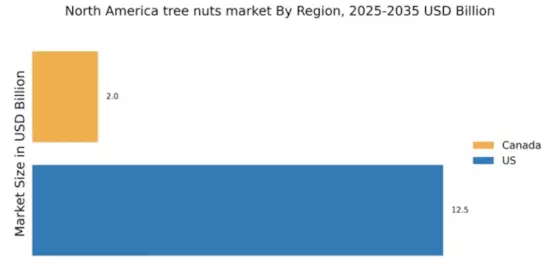Increased Snacking Trends
The shift towards snacking rather than traditional meals is significantly impacting the tree nuts market. As lifestyles become busier, consumers are opting for convenient, healthy snack options, with tree nuts emerging as a preferred choice. The market data indicates that the snack nut segment is expected to account for over 40% of total tree nut consumption in North America by 2026. This trend is driven by the perception of tree nuts as a wholesome, on-the-go snack that provides sustained energy. Additionally, the rise of e-commerce platforms has made it easier for consumers to access a variety of tree nut products, further propelling market growth. As the demand for healthy snacks continues to rise, the tree nuts market is likely to adapt by introducing innovative packaging and flavor options to cater to diverse consumer preferences.
Rising Health Consciousness
The increasing awareness of health benefits associated with tree nuts is a primary driver in the tree nuts market. Consumers are increasingly seeking nutritious snacks, leading to a surge in demand for almonds, walnuts, and pistachios, which are rich in healthy fats, proteins, and essential vitamins. According to recent data, the market for tree nuts in North America is projected to grow at a CAGR of approximately 5.5% over the next five years. This trend is further fueled by the growing popularity of plant-based diets, as tree nuts serve as an excellent source of protein and healthy fats. As consumers prioritize health and wellness, the tree nuts market is likely to see sustained growth, with manufacturers responding by expanding their product lines to include more nut-based snacks and ingredients.
Innovative Marketing Strategies
The implementation of innovative marketing strategies is playing a crucial role in shaping the tree nuts market. Companies are increasingly leveraging digital marketing, social media, and influencer partnerships to reach a broader audience. This approach is particularly effective in targeting younger consumers who are more likely to engage with brands online. Recent data suggests that brands utilizing social media marketing have seen a 30% increase in customer engagement. Additionally, storytelling and educational content about the health benefits of tree nuts are becoming integral to marketing campaigns. As competition intensifies, the tree nuts market is likely to witness a surge in creative marketing initiatives aimed at differentiating products and enhancing consumer awareness.
Sustainability and Ethical Sourcing
Sustainability concerns are increasingly influencing consumer choices, thereby impacting the tree nuts market. As consumers become more environmentally conscious, they are seeking products that are sourced sustainably. This trend is evident in the growing demand for organic and ethically sourced tree nuts, which are perceived as healthier and more environmentally friendly options. Market data indicates that organic tree nuts are projected to grow at a CAGR of around 7% over the next five years. Retailers are responding by emphasizing sustainable practices in their supply chains, which not only appeals to eco-conscious consumers but also enhances brand loyalty. As sustainability becomes a key purchasing criterion, the tree nuts market is likely to see a shift towards more transparent sourcing practices and certifications.
Growing Demand for Plant-Based Alternatives
The increasing shift towards plant-based diets is a notable driver in the tree nuts market. As more consumers adopt vegetarian and vegan lifestyles, the demand for plant-based protein sources has surged. Tree nuts, being rich in protein and essential nutrients, are becoming a staple in many households. Recent statistics suggest that the plant-based food market in North America is expected to reach $74 billion by 2027, with tree nuts playing a crucial role in this growth. This trend is not only limited to direct consumption but also extends to the incorporation of tree nuts in various food products, such as dairy alternatives and protein bars. Consequently, the tree nuts market is likely to benefit from this growing demand, prompting manufacturers to innovate and diversify their offerings.


















Leave a Comment